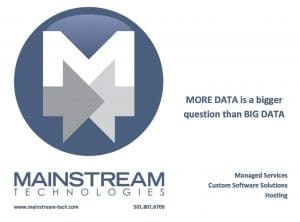
MORE DATA is a term describing the obvious. Every day we’re adding more and more data as we go about our business. We’re creating transaction data, emails, financial information, marketing information, operational data, images, CRM data and contract data in any number of formats that range from doc files all the way to pdfs and jpegs. Our data is growing at an alarming rate with no end in sight! According to a recent study by IDC, data is growing at a rate of 35% a year. This means companies must double their storage capacity every 24 to 30 months. The average company spends 13% of their IT budget on storage alone.
Kurt Marko is on the record in Information Week as saying “Data growth is an inescapable trend. In its “The Digital Universe in 2020” report, IDC estimates that the overall volume of digital bits created, replicated, and consumed across the United States will hit 6.6 zettabytes by 2020. That represents a doubling of volume about every three years. For those not up on their Greek numerical prefixes, a zettabyte is 1,000 exabytes, or just over 25 billion 4-TB drives. Or look at just one company as an example: UPMC, a major healthcare provider and insurer, has about 5 petabytes of data today, and that volume has been doubling every 18 months.”[1]
Since we’re digital hoarders (out of necessity), it’s up to us to have a plan so as our demand grows, our capacity will grow with it.
In order to have the right infrastructure in place that both maximizes our storage spend and keeps pace with demand, it’s important to understand the nature and characteristics of the different data sets being created. This will help determine the appropriate storage type and security measures for each set over the long term.
For example, if the data under review is rarely accessed and only needs to be placed on a shelf, cloud storage may be preferable. However, if data is frequently used and requires high speed access then another storage solution will be required. The other issue to consider is if a disruption occurs, what are the Restore Time (RTO) and Restore Point (RPO) objectives for the data.[2]
“The RTO or recovery time objective is the duration of time and a service level within which a business process must be restored after a disaster (or disruption) in order to avoid unacceptable consequences associated with a break in business continuity.
RTO can include the time required to assess a disruption, to determine and consider various repair options, the recovery itself if a resource is deemed to be lost or damaged beyond repair, post-recovery testing, and the restoration of service and communication to stakeholders.
The order of magnitude of the RTO (weeks vs. hours vs. seconds) will provide guidance as to the backup and recovery solutions to be assessed. “ [3]
RPO or restore point objective is defined as “…the maximum tolerable period in which data might be lost from an IT service due to a major incident. The RPO gives disaster recovery planners another limit to work to when designing an effective backup and recovery solution. For instance, if the RPO is set to 4 hours, then in practice, offsite backups must be completed every 4 hours i.e. a daily offsite backup on tape will not suffice.
RPO is completely independent of RTO. RPO is simply, the amount of data you are willing to lose in the event of an outage or disaster, or the amount of work or processing that would need to be repeated (or lost) following a successful recovery.
Regardless of how you choose to proceed, MORE DATA is a fact of life and here to stay. It will add complexity and cost (both hard and soft) to the enterprise but the good news is that it won’t be a surprise and there are resources out there to meet the challenge.
For more information about how Mainstream Technologies can help you meet your storage demands, contact Tom Allen @ 501.801.6700 or tom.allen@mainstream-tech.com.
[1]
[2] https://www.mainstream-tech.com/news-press/protecting-data/
[3] http://en.wikipedia.org/wiki/Recovery_time_objective





